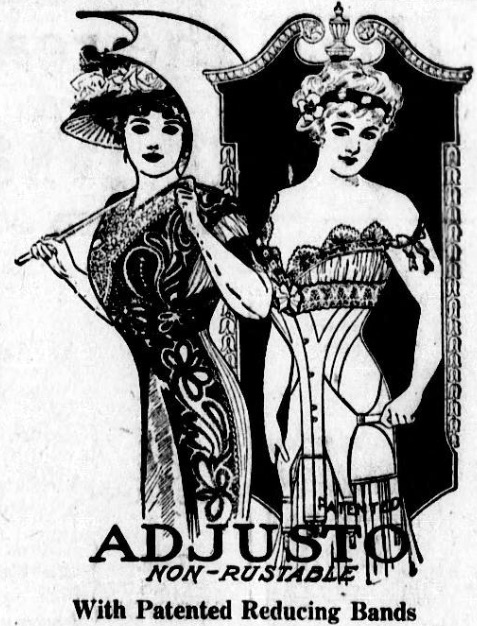
How did the women of the early 1900s deal with wearing corsets all day long, every day? Here are some corset wearing tips I dug up from the newspaper archives.

Corset Covers
When making a corset cover that is to be loose fitting and fastened by a drawstring at the top and at the waist line, stitch the shoulder straps to the upper edge of the back of the garment. Do not sew them in front, however, but fasten them either with a button and a buttonhole or with a small safety pin. Then when the corset cover is laundered you can unfasten these straps and iron the garment flat. A great convenience. [1915]
The First Wearing Of A Corset
A timely hint to corset purchasers is that given by a famous corsetiere. She says “it is all in the first putting on of corsets,” and for this reason she insists that her patrons shall be laced into the corset by the expert after making the purchase, the corset not to be removed that day until bedtime.
After this she guarantees that the corset will be perfectly comfortable, for the warmth of the body causes the bones to conform to the correct shape of the figure. [1915]
How To Wash Your Corset
Do the landing on a hot, sunny day, preferably one when a good breeze is blowing. Do not remove corset string. Have plenty of good lukewarm water and naphtha soap if possible, or if naphtha soap is not at hand add either a little borax or gasoline to water. Place corset out flat on board or table and with brush wet it thoroughly. Then begin to scrub from top to bottom with cool soap suds, if you use naphtha soap. Scrub the corset inside and out, being sure all the lines and seams which are usually the most soiled are clean.
Rinse the corset by using the scrub brush and clean, clear water, keeping the corset flat on the board but turning until each side is free from suds.
The more clear water used for rinsing, the whiter the corset will be.
A little bluing water turned on at the last. Hang the corset out in the sun, placing the corset lace over the clothes line. Keep in sun to dry quickly, thus avoiding rust. [1914]
The Back-Laced Corset
This style is really the best for all around service, as the stays both in the back and front help to preserve the original shape of the corset. For women who have any spinal trouble or those with weak backs, the back-laced models are a real boon. Many women feel as if they could not walk without this needed support. [1917]
Corset Preserves Figure Lines
Most doctors are in favor of corsets nowadays since corsets have been scientifically constructed to support and help the figure and are no longer intended merely to give lines of fashion. The graceful girdle corset of today, worn with a brassiere that holds the bust firmly, preserves the natural beauty of the figure and gives a trimness of effect that cannot be achieved when several garments are donned over the corset less figure. A corset of any kind makes its wearer remember to hold herself with more formality and correctness; without any corset at all most women would sooner or later fall into the slumping habit and lose what lines they had. And most figures uncarpeted would look anything but trim and graceful – and smart – under modern costume. [1921]
You Only Need Two
Do not invest in a number of corsets at one time. Have two corsets: one for common and the other for dress up wear. It is the same with underwear: a large supply of underwear is only an anxiety. If not looked after they frequently grow yellow or a vagrant, disrespectful mouse eats large pieces out of them. Styles, too, alter frequently in corsets and underwear, as they do in outer garments; also the human figure alters from time to time, and the garments are hopeless. [1910]
For A Full Bust
For a full bust, the corset must always be cut low, regardless of the styles prevailing at the time. Just now the low bust is popular. A high cut corset will make the wearer look stouter than she really is, while if she is short as well as stout she will look like a pouter pigeon parading. [1914]

